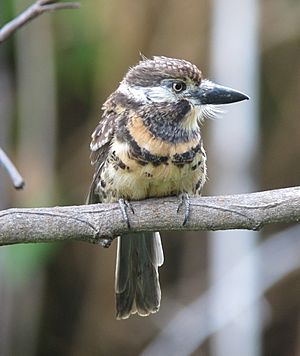Two-banded puffbird facts for kids
Quick facts for kids Two-banded puffbird |
|
|---|---|
 |
|
| Conservation status | |
| Scientific classification | |
| Genus: |
Hypnelus
|
| Species: |
bicinctus
|
| Synonyms | |
|
Hypnelus ruficollis bicinctus |
|
The two-banded puffbird (Hypnelus bicinctus) is a cool bird that lives in Colombia and Venezuela. It's part of a bird family called Bucconidae. This family includes puffbirds, nunlets, and nunbirds, which are known for their puffy feathers and often sit very still while hunting.
Contents
About Its Name and Family
Scientists have different ideas about how to classify the two-banded puffbird. When we talk about "taxonomy," we mean how living things are named and grouped.
- The International Ornithological Committee (IOC) and BirdLife International think it's its own special species. They say it has two types, called subspecies: H. b. bicinctus and H. b. stoicus.
- However, another group, the Clements taxonomy, believes it's just a subspecies of a different bird, the russet-throated puffbird.
So, even bird experts sometimes disagree on how to best group these amazing creatures!
What It Looks Like
The two-banded puffbird has some unique features:
- Its head is dark brown with lighter brown spots.
- It has a light brown patch from its beak to its eye.
- There's a white patch on its cheek and a black patch below it.
- A thin white band goes around the back of its neck.
- Its upper body is dull brown with whitish patterns.
- The tail is long, dark brown, and has light edges.
- Its chin is whitish, and its throat and upper chest are reddish-brown.
- The most special part: two black bands cross its chest!
- The rest of its belly is reddish-brown with black spots.
The subspecies H. b. stoicus looks similar but is a bit browner and lighter. Its face markings are also less dramatic.
Where It Lives and Its Home
The two-banded puffbird lives in different parts of South America:
- The main subspecies, H. b. bicinctus, is found in the plains (called llanos) of northeastern Colombia. It also lives in northern Venezuela, stretching east towards Guyana and south into the Amazonas and Bolívar states.
- The H. b. stoicus subspecies lives only on Margarita Island, off the coast of Venezuela.
On the mainland, these birds like open areas. They can be found in grassy savannas, thick bushes, old farms, and the edges of forests. They usually live below 500 meters (about 1,640 feet) in elevation. On Margarita Island, they prefer bushy areas and woods, from flat plains to hills.
Scientists haven't seen them move around much during different seasons. Sometimes, they are very common in one area, then they might leave for a few years.
Behavior
How It Finds Food
The two-banded puffbird is a "still-hunter." This means it sits quietly on a high branch or a shaded spot. When it sees prey, it quickly flies out to catch it. Its diet isn't fully known, but we know it eats insects.
Reproduction and Life Cycle
The breeding season for the two-banded puffbird seems to be in May and June. We don't have many details about it yet. These birds dig a burrow (a tunnel) inside a termitarium, which is a large nest built by termites on a tree. We don't know how many eggs they lay, but a related bird, the russet-throated puffbird, usually lays three eggs.
What It Sounds Like
The two-banded puffbird has a special song that sounds like a rhythmic "tak-ta-tóoo." It also makes a loud, croaking call. Sometimes, it even makes this sound while flying!
Its Conservation Status
The IUCN (International Union for Conservation of Nature) has evaluated the two-banded puffbird. They have listed it as a species of "Least Concern." This is good news!
- It lives across a large area.
- Even though we don't know its exact population size, scientists believe the number of these birds is stable.
- It's generally common in most places it lives on the mainland.
- Human activities don't seem to be a big threat to them right now.
- However, we don't know much about its status on Margarita Island.
See also
 In Spanish: Buco de dos bandas para niños
In Spanish: Buco de dos bandas para niños


